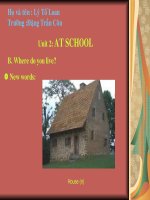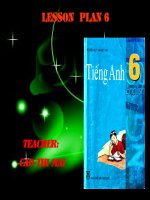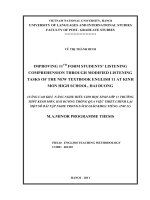- Trang chủ >>
- Mầm non - Tiểu học >>
- Lớp 5
5 4 4 the new kid at school TG
Bạn đang xem bản rút gọn của tài liệu. Xem và tải ngay bản đầy đủ của tài liệu tại đây (126.73 KB, 4 trang )
5.4.4
The New Kid
at School
GENERALIZE
GRAPHIC ORGANIZERS
This nonfiction selection is about
what it is like to be the new student at
school. It provides a lot of good suggestions
of what new students can do to make the
transition to a new school less difficult. It also
talks about what other students can do to
welcome the new student.
READ THE BOOK
LESSON VOCABULARY
STRATEGY SUPPORT: GRAPHIC ORGANIZERS
SUMMARY
cavities
demonstrates
profile
combination
episode
strict
INTRODUCE THE BOOK
INTRODUCE THE TITLE AND AUTHOR
Discuss with
students the title and author of The New Kid
at School. Based on the title, ask students
what kind of information they think this book
will provide. Direct students to look at the
cover photo to see if they can guess more
clues about the selection’s content.
BUILD BACKGROUND
SET PURPOSE
Have students set a purpose for
reading The New Kid at School. Students may
want to focus on Marcus and his problems at
the new school. Or they may want to focus on
what the other students do to help him feel
at home.
Remind students that graphic organizers are
story maps, webs, graphs, charts, timelines,
and other devices that help them understand
relationships among events, ideas, and words.
Give students practice in using a graphic organizer by having them make a problem/solution chart that lists the problems faced by a
new kid at school as they are described in
the book. For each problem, students should
identify the solution that is offered in the text.
Explain to students that they can use their
completed graphic organizers to remind them
of what they learned by reading The New Kid
at School.
Ask students if they have
ever been the new kid at school. If not, have
they ever helped a new kid trying to fit in at a
new school? Discuss some of the things they
did as a new student to make friends and fit
in. Also discuss things they did to make a new
student feel more at home.
What are some simple things you can
do to make a new student feel at home?
(Responses may vary: say hello, strike up a
conversation.)
Ask your ELL students what it felt like
for them on the first day at a new school.
What did they do to try to make friends?
PAGE 6 What are some different feelings that
might be a reaction to change? (Responses
may vary: excited, nervous.)
PREVIEW/USE TEXT FEATURES
PAGE 12
Have students
look through the book at all the photos.
Ask students how the photos give clues
to what is going to happen in the book.
COMPREHENSION QUESTIONS
PAGE 6
In addition to changing schools, what
major change is Marcus having to get used to?
(Responses may vary, but may include moving
from a house to an apartment, getting to know
a whole new town.)
PAGE 15
What are some of the ways you can
say goodbye? (Responses may vary, but may
include: say goodbye to friends and teachers,
take photos and mementos with you.)
84
The New Kid at School
16917_LRD_TG_084-085 84
2/3/06 10:28:32 AM
REVISIT THE BOOK
READER RESPONSE
1. Responses will vary, but may include: A
new student will feel nervous and alone.
She/he might not know where things are
in the school. She/he might be having problems at home that have caused the move.
The new student might want to find out how
to continue activities she/he did at the old
school or might want to use the opportunity
to try completely new things.
2. Possible responses: What he or she can
do: pursue a favorite activity, be yourself,
expect ups and downs. What we can do:
introduce yourself, start a conversation,
create a welcome gift, be a mentor, share
insider information.
3. Answers will vary.
4. Possible responses: Pursue activities you
enjoy, expect ups and downs, be yourself.
EXTEND UNDERSTANDING
Have students read
the eight section headings in the book. Ask:
How can the headings help you find information quickly? Have students use each heading
to explain what each section is all about. For
example, for the first heading, students might
answer, “This section is all about how to help
a new kid by introducing yourself.”
RESPONSE OPTIONS
WRITING
Have the students write a brief essay
about how to help a new kid at their school.
Have them imagine that they are sitting down
to start the day’s history class when the
teacher introduces a new student. What might
each student do to help the new student feel
more at home? What kinds of questions
would be good to ask the new student?
SOCIAL STUDIES
CONNECTION
Have the class brainstorm about what could
go in a welcome bag for a new student like the one discussed in the book on
page 10. Have the class create such
a welcome kit and give it to the next
new student who joins the class.
Skill Work
TEACH/REVIEW VOCABULARY
Review the vocabulary words. Then play
“Vocabulary Master” with students. Give
students three different definitions for each
vocabulary word, including one that is
fantastical or silly, and have them select
the correct definition and then use the
word in a sentence.
TARGET SKILL AND STRATEGY
GENERALIZE
Tell students: “Sometimes
when you read, you are given ideas about
things or people, and you can make a statement about all of them together. This statement is called a generalization. Look for
clue words, such as most, always, all, and
never. Valid generalizations are accurate.
Faulty generalizations are not accurate.” Tell
students that identifying faulty generalizations can help them tell whether an author
is biased. After reading, have students make
their own generalization by asking them to
generalize about new kids at school. (All new
students face problems at a new school.)
GRAPHIC ORGANIZERS
Remind students
that graphic organizers are used to arrange
information visually. Have them create a twocolumn chart and list each section heading
in the first column. In the second column,
students should write one generalization
made by the author for each section.
ADDITIONAL SKILL INSTRUCTION
CAUSE AND EFFECT Remind students that
a cause is why something happened, and
an effect is what happened. Point out that
causes and effects are sometimes not
obvious in the text, and sometimes there
are multiple causes for the same effect.
As students read, have them ask themselves: Why was Marcus worried on his
first day in his new school?
The New Kid at School
16917_LRD_TG_084-085 85
85
10/20/05 2:15:54 PM
The New Kid at School
Name
Generalize
• A generalization is a broad statement or rule that applies to many examples. A generalization is
made after thinking about a number of examples or facts and what they have in common.
Directions Reread the following passage from The New Kid at School.
A
bout his first day, Marcus says, “I
was worried about a lot of things.
The new school was much bigger than my
old one, and I was scared of getting lost.
I wondered if my new teacher would be
strict or nice. I was afraid I would never
make new friends or that other kids might
be mean to me.”
Directions Answer the questions below.
1. When we are afraid, we often make generalizations about the future. What generalizations does
Marcus make about the other students at his new school?
2. List another fear Marcus has about his new school.
3. List another fear Marcus has about his new school.
4. List another fear Marcus has about his new school.
6. How might you turn around the fear you listed in question 2?
7. How might you turn around the fear you listed in question 3?
© Pearson Education 5
5. What if Marcus could turn these negative expectations around? What would be a more positive
generalization he could make about his fellow students?
8. How might you turn around the fear listed in question 4?
86
16917_LRD_TG_086_087 1
10/20/05 2:16:17 PM
The New Kid at School
Name
Vocabulary
Directions Complete each sentence with a word from the box.
Check the Words You Know
cavities
demonstrates
profile
combination
episode
strict
1. Marcus was afraid that his teacher would be
.
of Star Trek.
2. The teacher told them to watch tonight’s
3. Marcus’s new school was a
4. The bulletin board in art class
5. Marcus had not had
6. The art teacher traced his
of old and new.
the students’ artistic talents.
for three years.
on a piece of paper.
© Pearson Education 5
Directions Write a brief paragraph discussing Marcus’s first day at school, using as many
vocabulary words as possible.
87
16917_LRD_TG_086_087 87
3/20/06 8:57:49 AM









